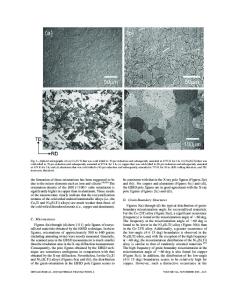What Controls Temperature Dependence of Yield Stress in L1 2 -Ordered Intermetallic Compounds?
- PDF / 1,509,823 Bytes
- 11 Pages / 595.32 x 841.92 pts (A4) Page_size
- 46 Downloads / 370 Views
What Controls Temperature Dependence of Yield Stress in L12-Ordered Intermetallic Compounds? Haruyuki Inui and Norihiko L. Okamoto Department of Materials Science and Engineering, Kyoto University Sakyo-ku, Kyoto 606-8501, Japan ABSTRACT The temperature dependence of yield stress and the associated dislocation dissociation in L12 intermetallic compounds are investigated in order to check the feasibility of the classification of L12 intermetallic compounds so far made in terms of the planarity of core structures of partial dislocations with b = 1/2 and 1/3 on {111} and {001} glide planes. In contrast to what is believed from the classification, the motion of APB-coupled dislocations is evidenced to give rise to the rapid decrease in yield stress at low temperatures for Pt3Al. In view of the fact that rapid decrease in yield stress at low temperatures is also observed in Co3(Al,W) and Co3Ti in which APB-coupled dislocations are responsible for deformation, the SISF-type dissociation is not a prerequisite for the rapidly decreasing CRSS for slip on (111) and the relative magnitudes of the APB energy on (111) and the SISF energy on (111) cannot be a primary factor that determines the type of the temperature dependence of CRSS for L12 compounds. The importance of the CSF energy as a factor determining the type of the temperature dependence of yield stress for L12 compounds through the changes in the planarity of the core structure of the APB-coupled partial dislocation with bp = ½[1 1 0] is discussed in the light of experimental evidence obtained from Pt3Al. INTRODUCTION Of many different intermetallic compounds, those with the L12 structure have been the most useful intermetallic compounds and have been extensively investigated for the last forty years due to the technological importance as the strengthening phase in heat-resistant Ni-based superalloys, and many excellent review papers have been published, promoting the understanding of the mechanical properties of L12 compounds on the basis of dislocation mechanisms [1-4]. Those L12 compounds that exhibit an anomalous positive temperature dependence of yield stress (yield stress anomaly) at high temperatures have the subjects of the most extensive studies, and Ni3Al is usually referred to as the representative L12 compound for this category, although many other L12 compounds such as Ni3Si, Ni3Ge, Co3Ti and so on are known to exhibit the yield stress anomaly in a similar way [1-4]. There are, however, some other L12 compounds that do not exhibit the yield stress anomaly [6-9]. Many of them are known instead to exhibit a large negative temperature dependence of yield stress at low temperatures. Pt3Al is usually referred to as the representative L12 compound for this second category. Vitek and co-workers [4,10-14] have pointed out that the difference in the temperature dependence of yield stress of L12 compounds of the two categories is explained in terms of the dissociation scheme of the dislocation with b (Burgers vector) = and the planarity of the core structure of the
Data Loading...











